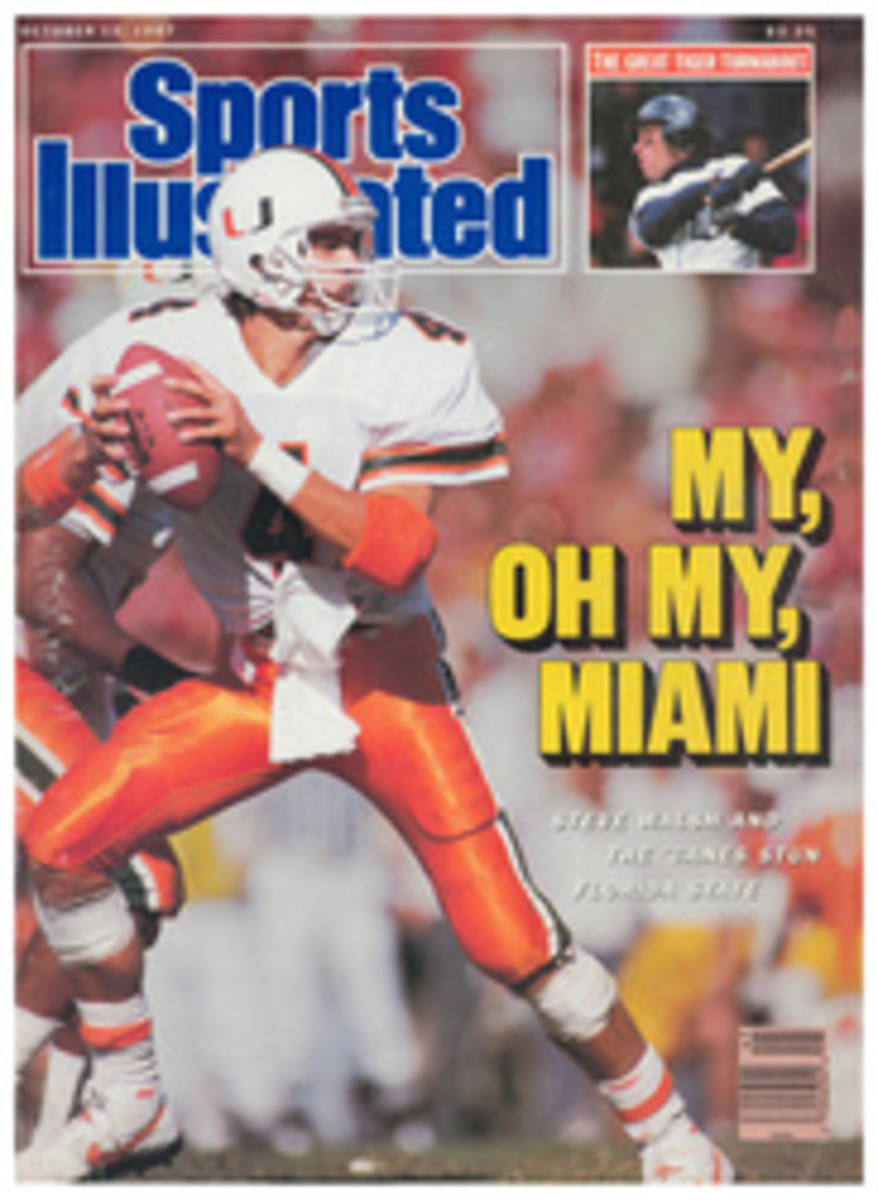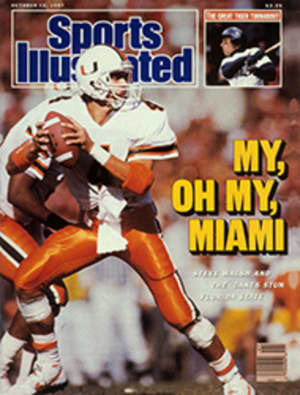
VAULTING FOR THE SKY AND OTHER NOT-FANCY FLIGHTS
I soloed an airplane when I was about 10 years old. It's hard to say exactly how old I was because I wasn't as conscious of age and time then as I am now. I'll admit, though, that on that particular day—it was probably in 1944 or '45—I came close to discovering something most kids don't know: We're all mortal.
My soloing took place over Bay City, Texas, where I did most of my growing up. A man there named Elmo Hatcher was a friend of my mother and stepfather. Elmo was a pilot, the kind of fellow boys my age just naturally gravitated toward.
His airplane was a fairly ancient Aeronca, a two-seat, low-wing craft capable of cruising about 70 mph with a good tail wind. But it was an airplane, and it represented part of my dream for the future. I hadn't quite decided if I wanted to be a professional ballplayer and a pilot, or to pursue my probable destiny as the first man to pole-vault 15 feet. In that era most people considered that height impossible, but I had always known I was bound for high places. So, day after day, there I was in my backyard, armed with a stout cane pole. I had already attained the dizzying height of 6'6" and considered the next 8½ feet a mere formality.
My future as an aviator got a boost from all the time I spent at the airport hanging around Elmo and his airplane. Despite my mother's strong disapproval, he had let me fly with him many times. I started out in the right (copilot's) seat, but when I was tall enough to reach the rudder pedals, Elmo would sometimes let me fly in the left seat and practice takeoffs and landings. At first he guided me through, letting me follow him on the controls, but after a time he began to lounge back in his seat and keep his hands and feet to himself while I flew the plane.
One Sunday, late in the summer, my parents went out to the airport with me, even though planes made my mother nervous. Well, that day Elmo and I took a short hop, and after we landed, we taxied over to the hangars where my parents were standing.
Elmo opened his door, got out and said, "You about ready to take it on your own? Solo?"
"Sure," I said, with a nonchalance born of ignorance.
"Go ahead then," he said, shutting the door. "Take it around the patch and land."
I didn't think any more about it. The fact that I had never been alone in an airplane before didn't enter my mind. I just lined up on the runway, poured on the power, reached flying speed and took off. I made the standard climbing left turn, put the plane on the downwind leg, reached pattern altitude and leveled off I don't remember being particularly nervous at that point. The presence of my instructor lingered, and I was automatically doing the things I had been taught. Then I made a left turn that would take me to the final approach.
At the proper moment I reached out and pulled out the throttle—or what I thought was the throttle; actually it was the knob to control the carburetor heat, which had nothing to do with increasing or decreasing power—and tilted the nose down to set up my glide path for the landing. Now, you don't land a light plane with the power on; you pull the throttle back to idle and control your speed with the angle of attack. As I guided the airplane toward the ground, lining up on the runway, I became aware of a strange feeling. I realized it was going much faster than it was supposed to, and there was that roaring sound that a powerplant makes at full throttle. I glanced at the airspeed indicator and saw I was doing 90 mph. Even as I watched, it started creeping toward the red line at 100.
I had descended to 300 feet and was well on my way to a high-speed crash. It was also about then that I became excruciatingly aware that I was in that plane all by myself. Total fear took over. I could think only that the throttle must be stuck, so I pushed and pulled the carburetor heat knob several times, but to no avail. The knob I wanted, the throttle, was right beside the carburetor heat control. The carburetor knob was yellow, and the throttle was white. I had manipulated that white knob a hundred times, but now—in one of those odd lapses that can befuddle the human mind at any age—it never entered my mind that it had anything to do with the throttle. I had fixed on that yellow knob, convinced it controlled the power.
I didn't crash. At 200 feet some instinct caused me to pull back on the wheel, climb, and make a go-around. Once again I flew the pattern, set up on my final approach, and pulled the carburetor heat knob. And once again I had to make a go-around.
Meanwhile, on the ground, I've been told, my mother asked Elmo who was in the airplane with me. He said, "Well, Grace, there were just the two of us in it before, and I got out. I guess that just leaves him."
That's when she began screaming at Elmo, "Get him down!"
Elmo replied, "Well, Grace, that ain't a kite up there. I can't just reel him in like he was on a string. Don't worry, he'll be all right." I'm sure Elmo meant it. Of course, that was before my second go-around. After that, I doubt he could have said anything that would have done much to reassure my mother. Her nervousness had turned to hysteria.
Naturally, I didn't know any of this. I was busy flying around and around the airstrip, vainly pushing in and pulling out the yellow knob. By now Elmo had figured out what my problem was. There was no radio in the Aeronca, so he had to go up and get me.
He borrowed a Piper Cub from another pilot, and the next thing I knew he was flying alongside me holding a message in large black letters on his window: PULL OUT WHITE KNOB. Naturally I did it. Automatically. Despite the fact that I had not even begun my approach. I pulled out the throttle and the roar from the engine became a gentle, idling purr. The airplane started to descend. Again, for some odd reason, my mind went blank. Instead of merely pushing the throttle in and picking up more speed, I nursed the airplane as far downwind as I could, maintaining a speed just above stalling, then made two gentle left turns and landed. I brought the plane to a stop, wheeled it around and stared at the two knobs, still wondering which one I should push to get up taxi power.
I thought that was the end of the episode (except for the state my mother stayed in for about a week), but some 10 years later I was accepted into the Aviation Cadet Program of the U.S. Air Force. While at preflight training, I wrote my mother and said Elmo Hatcher was my instructor. It had to be taken as a joke. Everyone knew that they don't let cadets in preflight near airplanes. But I hadn't taken into account my mother's continuing lack of knowledge about aviation.
Two weeks later I was summoned by my commanding officer. I went with fear and trembling. He had a letter in his hand, and he wanted to know who or what an Elmo Hatcher was. It seemed that my mother had written her congressman a colorful letter insisting she wouldn't have her son instructed in the air by "highly unorthodox persons." That congressman had passed the letter to the Air Force, and it had finally filtered down to my CO. I stammered out an explanation, but the officer was not amused. I spent the next two weekends marching punishment tours—six hours a day for four days.
You march punishment tours in white gloves. During those hours I had a lot of time to study my gloves and memorize the color white. It's not the same color as yellow. Yellow is the color of the carburetor heat knob. White is the throttle knob. White is the color that makes airplanes go up and down.
By the way, though I became a pilot, I never did play professional baseball. And I didn't become the first man to clear 15 feet in the pole vault. But I'm dead-solid perfect on white now.
ILLUSTRATION
RANDALL ENOS
Writer Giles Tippette of San Angelo, Texas, holds advanced pilot ratings.

